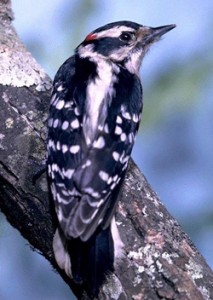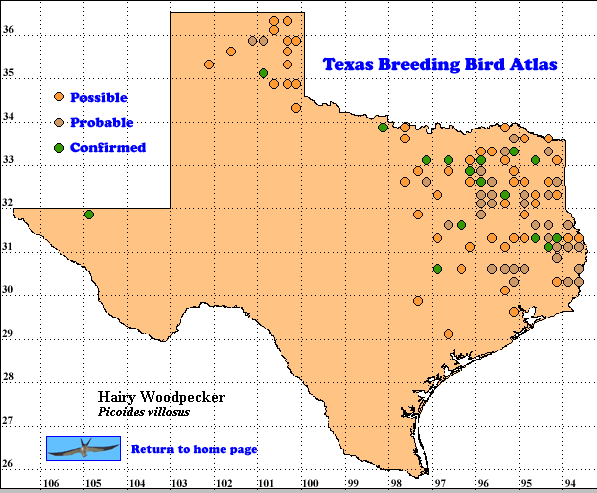Picoides villosus
INTRODUCTION: The Hairy Woodpecker is an uncommon to fairly common breeding bird in Texas (Oberholser 1974). This relatively small black and white woodpecker, however, is larger than the similarly plumaged Downy Woodpecker (P. pubescens) with which it is broadly sympatric (Short 1982). The Hairy Woodpecker occurs less often near human habitation than its smaller relative. With a little practice, the two species can be separated by voice and by bill length. The sexes of the Hairy Woodpecker differ in that males are 12 to 22 percent heavier than females and have a somewhat longer bill (Short 1982). In addition, the male has a narrow red nape patch which is lacking in the female (Oberholser 1974). The specific epithet villosus, Latin for “hairy” or “shaggy”, used to name this woodpecker, apparently refers to the appearance of the plumage (Gruson 1972).
DISTRIBUTION: TBBAP data show the Hairy Woodpecker breeding in much of the eastern third of Texas, as well as in the Canadian River drainage in the northeastern Panhandle, and in the Guadalupe Mountains of western Texas. In eastern Texas, TBBAP records indicate confirmed breeding west to Clay (33098), Freestone (31096), and Milam (30096) Counties, and probable breeding as far south as San Jacinto and Newton Counties (30095 to 30093). Oberholser (1974) shows confirmed breeding south to Harris County (29095) and resident status as far south as Victoria County (28096) (T.O.S. 1995). In the northeastern Panhandle, TBBAP data show a single confirmed breeding record at latilong 35100, quad B7. In the Trans-Pecos region, breeding was confirmed in the Guadalupe Mountains (31104, quad H7). The generally uncommon status of the Hairy Woodpecker in Texas is reflected by the relatively few confirmed breeding records in the TBBAP data.
SEASONAL OCCURRENCE: The Hairy Woodpecker, a permanent resident in most of its Texas range, breeds from mid-March to late August (Oberholser 1974). The TBBAP data correspond fairly well : there is a 1 April “on nest” record and a 6 August “fledglings observed” record. This woodpecker is also a rare to uncommon migrant and winter resident in parts of the High Plains, Edwards Plateau, the Trans-Pecos, and the central coast (T.O.S. 1995). In eastern Texas, Shackelford (1994) determined the relative abundance of eight woodpecker species and found the Hairy Woodpecker to be one of the least common. Only the endangered Red-cockaded Woodpecker (P. borealis) was less abundant. Of 143 TBBAP breeding records, 14% represent confirmed records. The remainder represents 38% probable and 48% possible breeding records.
BREEDING HABITAT: Hairy Woodpeckers breed in a variety of habitats including pine-hardwood forests and baldcypress swamps in eastern Texas, riverine forests in the Panhandle, and higher altitude coniferous forests in the Guadalupe Mountains. Nesting occurs less often in cultivated areas such as orchards (Oberholser 1974, Short 1982).
The Hairy Woodpecker nests in cavities excavated in dead (snags) or living trees (Oberholser 1974) as well as in dead or diseased portions of living trees (Winkler et al. 1995). Clutch size is three to six but usually four eggs (Oberholser 1974, Short 1982). The incubation period lasts 11 to 12 days, and nestlings fledge at 28 to 30 days of age (Harrison 1978). Both parents incubate eggs and tend nestlings. Hairy Woodpecker cavity trees in Virginia were found to be infected with a heart-rotting fungus (Conner et al. 1976). The fungus softens the heartwood, allowing for easier cavity excavation by the woodpecker. As with other cavity nesting birds, the Hairy Woodpecker often faces aggressive competition from the imported European Starling (Sturnus vulgaris) for nest sites (Kilham 1968).
STATUS: The Hairy Woodpecker is found in many different forested habitats throughout its widespread North American range. However, it seems less tolerant of areas near human habitations than some of the other woodpecker species (Oberholser 1974). Breeding Bird Survey (BBS) data indicate a small decline in Hairy Woodpecker numbers in the United States as a whole from 1966 to 1994 (Sauer et al. 1996).
In Texas, BBS trends show an overall increase in Hairy Woodpecker numbers from 1966 to 1994 (Sauer et al. 1996). However, the data from recent years (1980 to 1994) show a marked decline. Oberholser (1974) lists deforestation, climatic changes, and pollution as factors which seem to be involved in the species’ decline in Texas. Large snags are very important nest sites for many woodpecker species, including the Hairy Woodpecker. Timber harvesting makes up a large part of the economy in the “pineywoods” region of eastern Texas. During logging operations landownersoften remove large snags due to their susceptibility to fire and their potential to fall (McClelland and Frissell 1975). As a result, potential nesting sites may be greatly reduced in some areas.
Text by Richard Schaefer (ca. 1997)
Literature cited
Conner, R. N., O. K. Miller, Jr. ,C. S. Adkisson. 1976. Woodpecker dependence on trees infected by fungal heart rots. Wilson Bull. 88:575-581.
Gruson, E. S. 1972. Words for birds: a lexicon of North American birds with biographical notes. Quadrangle Books New Yoek, NY.
Harrison, C. 1978. A field guide to the nests, eggs, and nestlings of North American birds. Collins, New York, NY.
Kilham, L. 1968. Reproductive behavior of Hairy Woodpeckers II. nesting and habitat. Wilson Bull. 80:286-305.
McClelland, B. R., and S. S. Frissell. 1975. Identifying forest snags useful for hole-nesting birds. J. For. 73(7):414-417.
Oberholser, H. C. 1974. The bird life of Texas. University of Texas Press, Austin.
Sauer, J. R., S. Schwartz, B. G. Peterjohn, and J. E. Hines. 1996. The North American breeding bird survey home page. Version 94.3. Patuxent Wildlife Research Center, Laurel, MD.
Shackelford, C. E. 1994. Habitat characteristics of woodpeckers in pine and mixed pine-hardwood forests in eastern Texas. Unpubl. M.S. Thesis. Stephen F. Austin State University, Nacogdoches, TX.
Short, L. L. 1982. Woodpeckers of the world. Monog. Ser. No. 4, Delaware Museum of Natural History, Greenville.
Texas Ornithological Society. 1995. Checklist of the birds of Texas, 3rd edition. Capital Printing, Inc., Austin.
Winkler, H., D. A. Christie, and D. Nurney. 1995. Woodpeckers an identification guide to the woodpeckers of the world. Houghton Mifflin Co., New York, NY.

